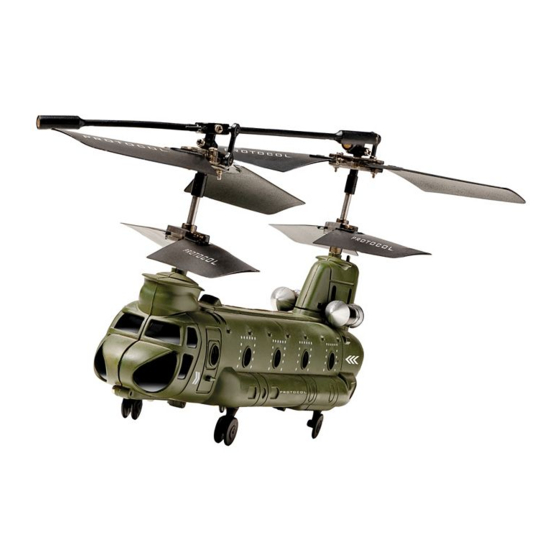
Advertisement
Advertisement

Summary of Contents for Protocol TACTICAL CARGO
- Page 1 TACTICAL CARGO REMOTE CONTROL HELICOPTER INSTRUCTION MANUAL...
- Page 2 FCC Statement This device complies with Part 15 of the FCC Rules. Operation is subject to the following two conditions: (1) This device may not cause harmful interference, and (2) this device must accept any interference received, including interference that may cause undesired operation. NOTE: This equipment has been tested and found to comply with the limits for a Class B digital device, pursuant to Part 15 of the FCC Rules.
- Page 4 THANK YOU. Thank you for your purchase of Protocol’s Tactical Cargo Remote Control Helicopter. You are about to experience the best of what remote control flight has to offer. We strongly recommend that you take the time to read this manual thoroughly.
-
Page 5: Table Of Contents
TABLE OF CONTENTS Safety & Precautions Parts Remote Battery Installation Charging the Helicopter Start-Up Procedure Operation Trim Adjustment Troubleshooting Fly Aways Replacement Parts & Limited Warranty... - Page 6 • Never attempt to modify function of vehicle or controller or attempt • repairs using parts other than those supplied by Protocol. Spare parts are available at www.ProtocolNY.com THIS DEVICE USES COMPONENTS THAT OPERATE AT HIGH SPEEDS. AS WITH ANY SUCH DEVICE, USE CAUTION TO OPERATE SAFELY.
- Page 7 PARTS HELICOPTER 1. Canopy 2. Blade 3. Balance Bar 4. Charging Port (underneath) 5. Power Switch (underneath)
- Page 8 PARTS REMOTE 1. Power On/Off 2. Forward/Backward 3. Left/Right Turn 4. Take Off/Land (short press) 5. Stop Engine (press for 3 seconds) 6. Right Trimmer 7. Left Trimmer 8. Throttle...
-
Page 9: Remote Battery Installation
REMOTE BATTERY INSTALLING THE BATTERIES 4 X ‘AAA’ (NOT INCLUDED) BATTERY COVER Remove battery cover from controller. Insert 4 x ‘AAA’ batteries according to indicated polarities. Replace battery cover. 1. Install batteries carefully. 2. Do not mix old and new batteries. 3. -
Page 10: Charging The Helicopter
CHARGING THE HELICOPTER BATTERY 1. Make sure the helicopter is turned off. 2. Connect the USB charging cable to the helicopter charging port. 3. Plug the charger into a USB port. The USB light will stay off while charging and will turn on once fully charged. Charging time: 60 minutes --- Flying time: approximately 6 minutes DO NOT CHARGE OVERNIGHT OR BEYOND THE CHARGING TIME STATED. -
Page 11: Start-Up Procedure
START-UP PROCEDURE Before flying, the helicopter and transmitter must be turned on in sequence and synchronized. 1. Turn on the helicopter. 2. Place the helicopter on the ground facing away from you. 3. Turn on the remote control. 4. Push the throttle up and then down. The light on the remote will turn steady to indicate it has synced. - Page 12 OPERATION: FLYING THE HELICOPTER TAKE–OFF: 1. From idle mode, press the take off button or gently advance the throttle up to a desired height and release. The helicopter will hover at that height.* TAKE OFF BUTTON LANDING: 1. Press the land button and the helicopter will automatically land. 2.
- Page 13 OPERATION: FLYING THE HELICOPTER FIRST TIME FLYERS!!! TAKE YOUR TIME! GO SLOW! Practice hovering until you are comfortable with flight before attempting any other maneuvers. If you start to lose control, don’t panic. Just press land. Push the direction lever up or down, the helicopter flies forward or backward.
-
Page 14: Trim Adjustment
TRIM ADJUSTMENT Press LEFT TRIM When the helicopter spins left unintentionally, you can correct it by pressing the right trim button until it evens out. Press RIGHT TRIM When the helicopter spins right unintentionally, you can correct by pressing the left trim button until it evens out. -
Page 15: Troubleshooting
Failure to do so could wear out and shorten the life of the motors. SYMPTOM POSSIBLE CAUSE POTENTIAL SOLUTION Tactical Cargo 1. Communication between 1. To synchronize, turn on aircraft does not controller and aircraft was not... - Page 16 TROUBLESHOOTING HOW TO CHANGE THE BLADES All helicopters have two blades that spin clockwise and two blades that spin counter-clockwise. Make sure to place the blades on the correct axis or they will not spin correctly and the helicopter will not lift. Each blade is marked with A or B.
-
Page 17: Fly Aways
FLY AWAYS HOW TO PREVENT FLY AWAYS To prevent “fly-away” situations (where helicopters seem to fly away out of control) it is important to first test and practice within close range before letting the helicopter fly too far away. Each helicopter is designed to turn off the engines if the radio signal is lost. It is important to know and test the range of your helicopter before flying. - Page 18 REPLACEMENT PARTS Thank you for your purchase of Protocol’s Tactical Cargo Remote Control Helicopter. We know that accidents can sometimes happen and that is why we offer spare parts kits on our website: www.ProtocolNY.com. LIMITED WARRANTY At Protocol, we’re dedicated to bringing you innovative and well-designed products that make living fun and easy.





Need help?
Do you have a question about the TACTICAL CARGO and is the answer not in the manual?
Questions and answers